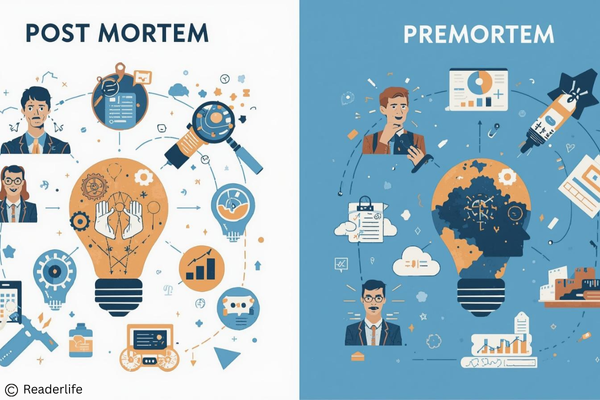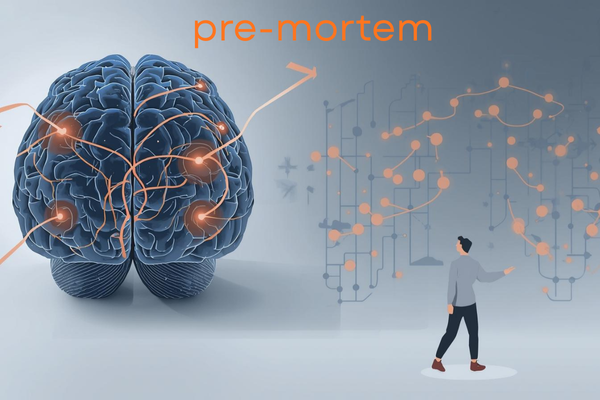Pre-mortem: Why Thinking Ahead Matters More Than Looking Back
In business, healthcare, aviation, and even our personal lives, the term post-mortem is common. A post-mortem happens after a crisis, failure, or mistake. Experts gather to analyse what went wrong, identify root causes, and develop lessons for the future. While valuable, it only works after damage has already occurred.
Imagine being able to foresee and prevent problems before they even occur. This is the essence of pre-mortem planning. It’s a proactive strategy where individuals or teams anticipate potential failures, identify weak points, and devise strategies to avert disaster. Instead of reacting to mistakes, pre-mortem planning illuminates blind spots early, fostering resilience and preparedness.
In this blog, we’ll explore premortem, the science behind stress and decision-making, and how you can use pre-mortem analysis in your daily life to reduce overwhelm and boost confidence.
Table of Contents
Post-Mortem vs Pre-Mortem: Understanding the Key Difference
A post-mortem is a response to an event. It involves a thorough examination carried out following a failure, crisis, or loss. For example, when a person experiences a setback, they conduct a post-mortem to grasp how it occurred.
A premortem, on the other hand, is proactive. It assumes failure before it happens and asks:
- What could go wrong?
- What blind spots might we be missing?
- How can we prepare for or prevent a disaster?
Engaging in premortem thinking allows you to simulate a failure scenario and enhances your capacity to manage uncertainty. When comparing post-mortems to pre-mortems, the latter consistently enables you to take proactive measures and prevent avoidable challenges.
The Role of Stress in Decision-Making: Why Pre-mortem Helps

When we experience high levels of stress, our bodies activate a survival mechanism. The adrenal glands secrete cortisol, the heart rate increases, and adrenaline circulates. Although this response is beneficial in critical situations, it can hinder logical thinking when faced with complicated decisions.
This is why a premortem analysis is so effective. By preparing in advance, you can avoid the debilitating effects of stress and gain a sense of relief. Rather than rushing to figure things out in the moment, you have strategies ready to go. The premortem approach offers clarity when your mind might otherwise freeze or lead you to make rash, emotional decisions.
The Neuroscience Behind Pre-Mortem Thinking
The human brain has developed the ability to recognise patterns and retain critical survival information. For instance, the hippocampus plays a key role in helping us remember sources of food, places to seek shelter, and potential dangers. Nonetheless, our brains are more effective at recalling stationary objects than they are at remembering rapidly changing and dynamic threats.

This is why, in daily life, simple proactive strategies help:
- Assigning a fixed place for essentials like passports, glasses, or keys.
- Please take photos of important travel documents and email them to yourself.
- Creating a checklist before trips to reduce last-minute panic.
These are micro examples of a premortem mindset—anticipating possible problems before they trip you up. By practising such strategies, you strengthen your ability to think ahead under pressure.
Implementing a Pre-Mortem in Professional and Personal Life
1. In Business and Projects
Before launching a new product, project teams can perform a premortem analysis by imagining the product has failed. Each member brainstorms reasons for the failure: lack of demand, poor marketing, technical glitches, or missed deadlines. By surfacing these risks, the team can design preventive measures.
2. In Healthcare and Safety
Healthcare facilities apply premortem planning to foresee potential medical mistakes. Before a surgery, teams inquire: If this procedure does not succeed, what might be the reason? By exploring these scenarios, they enhance safety measures and mitigate risks.
3. In Personal Life
Individuals can apply the same principle to everyday challenges. For example:
- Preparing backup plans before travel.
- Consider financial setbacks when budgeting.
- Consider emotional stress points before making a big decision, such as marriage or moving.
In all these cases, premortem analysis creates a cushion against uncertainty, providing a sense of security. It ensures that you’re not caught off guard, but rather prepared for whatever comes.
Why Pre-Mortem Planning Builds Resilience
Setbacks are a common experience for everyone. Everyone faces difficulties, but the way we get ready for them distinguishes between giving up and bouncing back. Engaging in pre-mortem thinking regularly helps to integrate failure into your process. Rather than being caught off guard, you become mentally prepared to react.
This mental readiness alleviates anxiety, as you have already practised handling the worst-case scenarios. It also enhances confidence, knowing you have alternative strategies in place. The primary advantage of pre-mortem analysis lies not only in preventing issues but also in developing a mindset to manage whatever arises.
Step-by-Step Guide: How to Conduct a Pre-Mortem Analysis
Define the project, goal, or event.
Be specific. For example: launching a new app, preparing for a presentation, or planning an international trip.
Imagine total failure.
Assume the worst has happened. The app flopped. The presentation bombed. The trip went off track.
List all possible causes.
Brainstorm without filters. Think of technical issues, human errors, external risks, and personal blind spots.
Prioritise the most significant risks.
Some issues will be minor, while others could completely derail success. Focus on the latter.
Develop preventive strategies.
For each significant risk, outline proactive measures.
Assign responsibility.
Make sure someone owns the preventive strategy. Without accountability, the pre-mortem remains theoretical.
Review and update regularly.
Conditions change. A good premortem analysis evolves as projects or life circumstances shift.
Practical Examples of Pre-Mortem Thinking
- Travel Example: Imagine your passport gets stolen abroad. A pre-mortem solution? Keep digital copies, inform your embassy of your location, and carry backup ID.
- Work Example: If your presentation fails, what’s the cause? Weak data, lack of clarity, or tech failure. A pre-mortem solution: rehearse, bring backups, and prepare FAQs.
- Finance Example: If your investment portfolio collapses, why? Market volatility, lack of diversification, or panic-selling. A premortem strategy involves diversifying assets, setting stop losses, and automating savings.
These examples highlight how pre-mortem analysis can save time, money, and stress in real-world scenarios.
The Psychological Benefits of Pre-Mortem Thinking
Beyond practical problem-solving, the premortem approach trains your mind to embrace uncertainty with curiosity rather than fear. It encourages:
- Detachment from perfectionism – failure is assumed, not feared.
- Improved creativity – by brainstorming failure points, new solutions emerge.
- Emotional resilience – because you’ve mentally rehearsed challenges, setbacks feel less overwhelming.
In a sense, the pre-mortem technique transforms anxiety into preparation.
Post-Mortem vs Pre-Mortem: Which Is Better?
Both approaches hold significance. A post-mortem provides insights after an event occurs, whereas a pre-mortem allows you to foresee potential issues. Combined, they foster a continuous cycle of learning and preparation.

Nonetheless, in the current fast-paced and high-pressure environment, depending solely on post-mortems poses risks. By integrating premortem assessments, individuals and organisations can minimise failures, protect their resources, and cultivate lasting resilience.
Why You Should Start Practising Pre-Mortem Today
Life and work involve a lot of uncertainty. Stress can impair decision-making, setbacks occur, and errors are unavoidable. However, you can prepare yourself to handle these challenges. By applying premortem analysis, you can identify potential risks, enhance your stress response, and lower the chances of disaster.
Whether you’re strategising a business initiative, dealing with personal transitions, or simply getting ready for daily obstacles, adopting a premortem perspective will make you more alert, composed, and resilient.
So, when you’re about to start something significant, don’t merely wish for positive outcomes. Conduct a premortem, identify possible pitfalls, and move forward with assurance.
Also read: The Science Behind Automaticity: How Repetition Changes Behaviour

